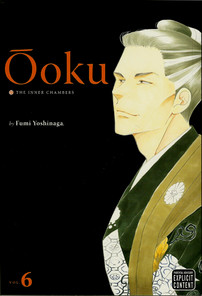Review
by Rebecca Silverman,Ōoku: The Inner Chambers
GN 6
| Synopsis: |  |
||
In the twilight years of Tsunayoshi's reign, there is much to-do about her successor. She favors Ienobu, but her doting father holds a grudge and wants a less seasoned relative named heir. Already unpopular, Tsunayoshi must decide whether or not she can get out from under Keisho-In's thumb. After her death, the stage is set for a new shogun and her attendant scandals, as the story moves closer and closer to the place where it began. |
|||
| Review: | |||
The most discussed aspect of Fumi Yoshinaga's alternate history where most of the men have died of the mysterious Redface Pox is undoubtedly the language. Viz's decision to translate the series into antiquated, Shakespeare-style English has garnered a lot of commentary, both positive and negative, and such discussion is unlikely to stop with this volume. While the language does make reading the books more difficult for some, the strongest point in its favor is that it provides a way for translator and English adapter Akemi Wegmuller to convey a formality of language that otherwise would be lost. English's informal form of address – thee/thou – was dropped in the late nineteenth century, though it had gone out of common usage roughly one hundred years before, and regretfully for translations from other languages that do retain both a formal and an informal second person, it is difficult to approximate the nuance. Ōoku's circumvention of that is difficult, but in some regards necessary. Language issues aside, this volume retains the stately pace of its predecessors. Yoshinaga is more interested in portraying the daily lives of the women on the throne and those surrounding her than the politics of the day, although certain issues, such as Tsunayoshi's unpopular Edicts on Compassion for Living Things, do get a mention. The focus for most of the book is Tsunayoshi. Where the few volumes before this one also dealt with her reign, this one zeroes in on Tsunayoshi herself rather than the men of her Inner Chambers. Where before we saw the shogun as a frivolous woman, now she is revealed to be human behind her mask – a woman devoted to her father to the point of neglecting her duties and who seeks pleasure to cover the pain of her daughter's death. The result is that a previously unlikeable character becomes, at least briefly, sympathetic. Yoshinaga's art reflects this, using simple symbolism such as decreased formality of dress and one particularly well done scene of Tsunayoshi freeing herself from her father's grasp. Sir Keisho-In, whom readers have known since he was the young monk Gyokuei, is another character whose decline is well documented. He has become querulous and senile, a trend we saw start in volume five. His grip on his daughter is weakening, but he is unaware of the fact, making his state all the sadder. Yoshinaga's visual depiction of him, as well as other characters we have seen since their youths, is skillful. It is still clear who everyone is, but the aging process looks natural and complete. In a medium where parents routinely look the same age as their children, this is remarkable. The timeline of the series gets a bit jumbled in the middle of the volume. Because the shogun we began the series with, and whose reign we are returning to, is from a branch family, Yoshinaga takes time to document that family's struggles, which at times takes us out of the continuity we've been following in Edo. It can get confusing, and Yoshinaga's art does not always make it clear how old the various young women are. In one scene a girl looks to be in her teens, but when the panel zooms out, she looks like a small child. This further complicates issues of time, something which has consistently been an issue for the series. What may be the largest deterrent to readers is a small mother/son incest storyline in the second half of the volume. The story is documenting the father of Ienobu's child, and his past is a troubled one. This does include a relatively graphic sex scene, so if this is likely to bother you, be warned. Yoshinaga doesn't devote a lot of time to it, but it's still clear what's going on. This volume also ups the sex scene count a bit, though not by much. Mostly Yoshinaga is fairly tasteful in her depictions, so the M rating may feel overcautious to some readers. This series is definitely more for the history buffs than those looking for prurient content. While Ōoku is still a slow moving tale of an alternate past, it also remains interesting and engrossing, particularly as we get closer to the series' starting point. Despite the difficulties inherent in the translation, it is a solid story of what might really have been behind Japan's closed door policy and an interesting study of who might have sat on the throne. |
|
The views and opinions expressed in this article are solely those of the author(s) and do not necessarily represent the views of Anime News Network, its employees, owners, or sponsors.
|
| Grade: | |||
Overall : B+
Story : B+
Art : A-
+ Good depictions of the aging process both physically and mentally, interesting look at some of the characters. |
|||
| discuss this in the forum (2 posts) | | |||
| Production Info: | ||
|
Full encyclopedia details about Release information about |
||